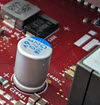
The fifth CaSA, Computer and System Architecture Unraveled, meetup took place on January 30. We finally gave in and joined the AI hype train, resulting in an event with a somewhat different audience and different discussions. More society and applications, less computer architecture. Our two presenters were Håkan Zeffer from SambaNova Systems and Björn Forsberg from RI.SE (doing his second CaSA presentation!). Håkan talked about the architecture of the Sambanova AI processors, and Björn about AI compilers.
Continue reading ““Unusual Perspectives on AI” – Computer and System Architecture Unraveled Event Five”

